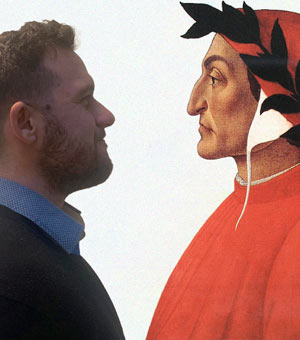
Thursday Soapbox: Getting on a Soapbox!
News 19 MarchWe invited a broad range of speakers from our staff community to speak about a topic they were passionate about.
01 July 2021
Share
“Video Killed the Radio Star,” so sang the Buggles back in 1978. A catchy song, but perhaps not prophetic enough, as it seems to me that video killed much more than simply that. And so begins my wistful lament for what movies used to be and how they once played such a central part in our lives.
But before I really get going, you’ve probably already raised an objection.
"Movies still play a central part in our lives,”
you may say, “even more than before, because now we have a whole streaming library at our fingertips that we can take with us via our phones, iPads and countless other devices.”
“Sure,” I reply, unable to hold back a smidgen of smugness in my tone, adding, “and that is exactly my point.” Let me explain.
This ownership over movies where we are able to stop and start them as we want, watching them alone wherever we want, was not what was intended when movies were originally made. Movies were made for the cinema. That is, they were made to be watched with others, as a community experience, in a public space, like the church and the pub. Too often we forget about this community aspect, thinking we are simply sitting in the dark, engaging with nobody. But that misses the point. Instead, the cinema experience can be one of great intimacy – an intimacy that comes from sharing tears and sharing laughter, that transcends personal relationships to be shared by a whole cinema audience who in some mysterious way, become “one body”. They become “one audience.”
This is the authentic cinema experience.
Cinema-goers of the past may not have thought much about this, but they instinctively knew it to be the case. Movies formed communities and formed culture, using visible images to offer more than simply entertainment. Movies were complete experiences with transformative potential, for good or for bad. They tapped into the religious senses of the people, but offered entertainment instead of liturgy, within the same context of community.
Let me use a Catholic image to explain. At the Mass, people came together as “one Body” to receive the “Sacrament” and then, to become what they have received. At the movies, people came together as “one audience” to receive sacramentally what was given: visible images revealing an invisible meaning in the telling of a story, such that the audience starts to become what they have received.
Today the sacramental richness of the 'cinema experience’ seems to be following ‘religious experience’ out the door. Liturgy has always been theatrical but now both liturgy and cinema have been consigned to the realm of 'individual’ experience, divorced from the social fabric of the community.
As community gives way to isolation, our culture more readily loses itself. As the sacramental is lost, the invisible is harder to see and such things as faith, hope and love become less tangible. We are unmoored from the community, losing both the religiosity of the cinema experience and the theatricality of the liturgy.
These COVID-times have given us a jolt to remember what it is we are losing. Lockdowns have opened our eyes once again to the sacramental. We realise our own need for those “invisible realities” we experience often through the social engagement of our senses and the freedom to be with others. Now more than ever, we can move away from the individualism of our culture, whether that be the privatisation of watching movies or the unwillingness to engage in public worship. Let us return to both, the cinema and the church, recognising our need to be transformed by the sacramental and incorporated into community, able to become the people we are called to be, filled with those invisible realities that shape our human existence.
Jeremy Ambrose is the Campus Pastoral Associate for Staff at the Melbourne campus. He is expecting his first child (five weeks from the publication date of this article) and knows time for his interest in classic films, literature and Elvis Presley music is about to be heavily reduced.

We invited a broad range of speakers from our staff community to speak about a topic they were passionate about.

Irish coffee has so many things happening all at once... just like the Catholic faith. Jeremy Ambrose, Campus Pastoral Associate (Staff) on the Melbourne Campus, having an Irish Godmother and wife, hi...

Who is God? Personal, and Alive! Nathan Costin, Campus Ministry Manager, reflects on the Lenten journey and the deepening encounter with Jesus to draw us closer to the living God.

Synodality is our future and our reality". Maddy Forde talks at the NCEC conference introducing the concept of synodality from a young person's position

The miracle of the human body is epitomised through the healing vocation of Physiotherapy, and this skill is cultivated through the selfless gift of body donors.

Jean-Claude encourages us to 'keep our poker faces out of our relationships' and work on strengthening our integrity by becoming beacons of truth and goodness after reflecting on his recently viewed b...

By inviting others to share in your journey of real life experiences, disappointments, anxiety and fears makes us realise we are not alone. Gabby challenges us to surrender our burdens to feel humble...

“We are not made to be solitary, but we are made for community.” Paolo Grella reflects on his experience of community over the years and how it adds a vital element to life.

No matter how long the night, the sun will always rise! Colleen Tracey shares her recent experience with COVID-19 and reminds us to tap into the 'grace' in every challenge and obstacle, to remain pos...

Saints, the great heroes of the Catholic tradition, faced challenges and adversity during their lives. Inspired by their feats and acts of virtue, Jake Santitto reflects on the challenges that they fa...

Hannah Scullion, Campus Pastoral Associate, talks about how experiencing pregnancy gives her a new and more relatable perspective on how she views her relationship with Mary, our spiritual mother.

How can we, with our individual power, use our daily choices to convey hope, support brave changes, and walk alongside our First Nations sisters and brothers? Maddy Forde, Campus Pastoral Associate ur...

Society portrays a certain image of what masculinity is. Paolo Grella reflects on this and how his understanding has changed over the years, leaving behind words of encouragement for others.

Join Jake Santitto, Campus Pastoral Associate (Student), as he dives into Dante’s divine comedy and is drawn into the 3 realms of the Christian afterlife to see how literature can transform your life ...

How can you be a fool for God, not only for one day but for a lifetime ahead? Jeremy Ambrose, Campus Pastoral Associate.

To lift up and give hope to those despairing, Colleen Tracey, Campus Pastoral Associate asks us to live in the here and now to embrace the grace and let the light of God's love come out of the darknes...

Father Harry Chan, Banyo Campus Chaplain, reflects on why God may seem so silent when we are experiencing the tough times in our lives.

What makes thirty young adults gather at a university campus on a Friday evening? The promise of engaging conversation and encouraging formation, of course.

Processing the turmoils of life can seem almost impossible at times yet, Gabby Fernandes, Campus Pastoral Associate (Students), encourages us to take the time to stop and reflect to allow room for hop...

ACU is called to live out and express its identity and mission in a range of ways. At ACU, prayer is a way of acknowledging our commitment to seek the truth and is integral to the core mission values...